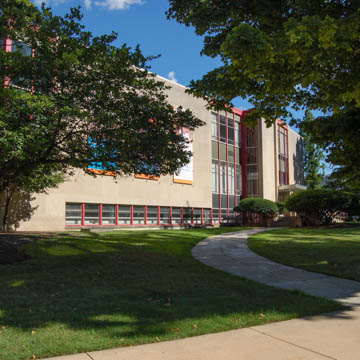You are here
George Gund Building
For more than four decades the Cleveland Institute of Art (CIA) occupied an Italianate building in University Circle, northeast of Wade Park. Though the area entered a period of slow decline after World War II, due to the effects of suburbanization and other socioeconomic factors, CIA and many of its neighboring institutions stayed put and dedicated themselves to the area’s redevelopment. In 1956, CIA moved into a new building to the south, just opposite the Cleveland Museum of Art. Named for George Gund, the Cleveland philanthropist and longtime president of the CIA, this International Style building was designed by the firm of Garfield, Harris, Robinson and Schafer. It has a canted composition that takes advantage of its lozenge-like site at the intersection of East Boulevard and Bellflower Road. The building’s broad limestone facades imbued it with institutional monumentality; the glass curtain walls gave it functional modernity. The curtain walls are framed in red with slightly inset horizontally banded windows that brightly illuminate classrooms and studios. Opaque spandrel glass faces the mechanical levels between the principal floors of the building, its deep forest green color blending in with the landscaping, trees, and foliage that surround the building especially on the East Boulevard side (the rear parking lot faces Bellflower). In 1981, CIA purchased the Albert Kahn-designed Ford assembly plant on Euclid Avenue and converted it for use by its fine arts programs. The East Boulevard building continued to serve as the administration offices and digital and media classes for CIA, until it was sold jointly to the Cleveland Museum of Art and Case Western Reserve University in 2014.
References
Cleveland Institute of Art. “History.” Accessed March 20, 2016. http://www.cia.edu/about-us/history.
Writing Credits
If SAH Archipedia has been useful to you, please consider supporting it.
SAH Archipedia tells the story of the United States through its buildings, landscapes, and cities. This freely available resource empowers the public with authoritative knowledge that deepens their understanding and appreciation of the built environment. But the Society of Architectural Historians, which created SAH Archipedia with University of Virginia Press, needs your support to maintain the high-caliber research, writing, photography, cartography, editing, design, and programming that make SAH Archipedia a trusted online resource available to all who value the history of place, heritage tourism, and learning.




